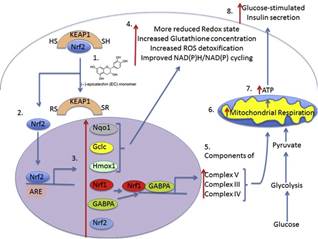


糖尿病患者经常被警告不要吃太多巧克力。但现在杨百翰大学(BYU)的研究人员在可可中分离出一种化合物,可以通过推动增加β细胞分泌胰岛素的能力来帮助抗击 2 型糖尿病。2 型糖尿病发生发展的一个最主要的原因是胰岛β细胞功能的减退。
胰岛素是一种调节血糖水平的激素。另外β细胞还分泌了一种称为胰岛淀粉样多肽的激素,其将制糖作用进入血液中。然而,在 2 型糖尿病患者中,β细胞功能减退并且无法有效地进行工作。
β细胞研究人员发现,在可可中发现的称为儿茶素单体的化合物能够增加β细胞分泌胰岛素的能力。
研究人员首先给小鼠喂食高脂肪食物,然后再给它们喂食可可化合物。他们发现儿茶素单体不仅有助于啮齿动物更好地应对升高的血糖水平,而且还减轻其肥胖程度。他们得出的结果与化合物对β细胞内的线粒体的作用有关。线粒体是细胞中制造能量的结构,将氧和营养物质转化为 ATP(三磷酸腺苷,一种用于将能量转移到全身的小分子)。
杨百翰大学营养学和食物科学助理教授 Jeffery Tessem 表示:“这发生的是保护细胞,其增加了处理氧化应激的能力。儿茶素单体使β细胞中的线粒体更强,从而产生更多的 ATP,从而导致胰岛素释放的更多。”
此前科学家曾经发现,肠道细菌能够将黑巧克力的关键成分可可粉分解成可以抑制有害的炎症反应的小分子;另外巧克力可可粉中含有的黄酮醇可以大大减缓年老记忆衰退现象, 并能够帮助心脏周边血管扩张, 减少罹患心脏病的风险
在这项研究中,研究人员指出,可可化合物的益处可能不仅仅是通过食用大量的巧克力来实现。Tessem 表示:“你可能要吃很多可可,你可能不希望它含有很多糖。可可的复合物实际发挥作用。”
Neilson 补充说:“这些研究结果将有助于我们更加有效地在食物中利用这些化合物,以保持正常的血糖控制,甚至预防 2 型糖尿病。”
该研究成果已发表在《Journal of Nutritional Biochemistry》上。(来源:生物360)
Monomeric cocoa catechins enhance β-cell function by increasing mitochondrial respiration
Abstract A hallmark of type 2 diabetes (T2D) is β-cell dysfunction and the eventual loss of functional β-cell mass. Therefore, mechanisms that improve or preserve β-cell function could be used to improve the quality of life of individuals with T2D. Studies have shown that monomeric, oligomeric and polymeric cocoa flavanols have different effects on obesity, insulin resistance and glucose tolerance. We hypothesized that these cocoa flavanols may have beneficial effects on β-cell function. INS-1832/13 derived β-cells and primary rat islets cultured with a monomeric catechin-rich cocoa flavanol fraction demonstrated enhanced glucose-stimulated insulin secretion, while cells cultured with total cocoa extract, oligomeric or polymeric procyanidin-rich fraction demonstrated no improvement. The increased glucose-stimulated insulin secretion in the presence of the monomeric catechin-rich fraction corresponded with enhanced mitochondrial respiration, suggesting improvements in β-cell fuel utilization. Mitochondrial complex III, IV and V components are upregulated after culture with the monomer-rich fraction, corresponding with increased cellular ATP production. The monomer-rich fraction improved cellular redox state and increased glutathione concentration, which corresponds with Nrf2 nuclear localization and expression of Nrf2 target genes including NRF-1 and GABPA, essential genes for increasing mitochondrial function. We propose a model by which monomeric cocoa catechins improve the cellular redox state, resulting in Nrf2 nuclear migration, and upregulation of genes critical for mitochondrial respiration, glucose-stimulated insulin secretion and ultimately improved β-cell function. These results suggest a mechanism by which monomeric cocoa catechins exert their effects as an effective complementary strategy to benefit T2D patients.
原文链接:http://www.sciencedirect.com/science/article/pii/S0955286317302279



